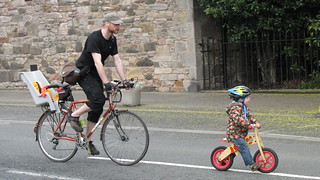Well it's recently been raised on other threads about 'students', 'no lights', 'the law' and 'safety'.
http://www.rdrf.org.uk/2013/11/17/do-bicycle-lights-make-any-difference-to-cyclist-safety
CityCyclingEdinburgh was launched on the 27th of October 2009 as "an experiment".
IT’S TRUE!
CCE is 16years old!
Well done to ALL posters
It soon became useful and entertaining. There are regular posters, people who add useful info occasionally and plenty more who drop by to watch. That's fine. If you want to add news/comments it's easy to register and become a member.
RULES No personal insults. No swearing.

Well it's recently been raised on other threads about 'students', 'no lights', 'the law' and 'safety'.
http://www.rdrf.org.uk/2013/11/17/do-bicycle-lights-make-any-difference-to-cyclist-safety
We often point out on this forum when posters object to the non-light cyclists that they have been seen.
Having lights makes it easier for you to be seen. But in built up areas you can be seen without lights.
Interestingly, no one Commenting, including the link highlighted, ever suggests not having lights.
Have never had a SMIDSY in the dark, only ever in the daylight.
”Have never had a SMIDSY in the dark, only ever in the daylight"
Must have had your lights on.
;-)
I'll put my vote behind 'yes', they make a difference. Let's take a (somewhat unscientific) look.
Many cyclists have stories of a vehicle pulling out in front of them (or similar) after the driver stared straight at the cyclist. In many cases fair cop, it might be an uncaring/risky driver, but in many cases, the eye has seen but the driver's brain has not perceived.
Which aspects of driver perception do cyclists have control over? Largely, contrast, movement and location (geographically that is, road position has covered lots before).
Lights: a steady light ticks the 'high contrast/brightness' box and is easy to spot. Flashing lights are even easier to spot because they get noticed by the part of your brain that detects change/movement in the visual scene.
Clothing is another part of it - but light colours aren't necessarily always the most effective choice. As someone pointed out recently, light colours after dark are not nearly as effective as reflective bits. In fact, in sodium street lighting, many 'bright' colours just appear closer to shades of gray. Arguably, a moving jet-black silhouette is more noticeable in street lighting than non-reflective light colours!
Movement doesn't need much analysis. A moving object is more visible to the eye than a stationary one, and funnily enough, peripheral vision is better at spotting movement. However, the effect gets drowned out pretty easily in busy traffic.
Location location. A medium strength light is probably all you need on an otherwise unlit route, or where there are not many sources of light. But other factors start to distract from and drown out your own lights: vehicles, traffic lights, well-lit roads and junctions, shop displays and signs, and so on. Then, add rain to reflect and refract light all over the place, and your own light suddenly has a much lower chance of standing out in the visual noise. So depending on the conditions, you may need to significantly up the lumens.
Lights probably don't make a huge difference to being seen in street-lighting areas, but it's enough of a difference that I'd prefer to benefit from it.
I'd argue that lights make a big difference to the ability of a motorist to see you if you are cycling through somewhere like Melville Drive, where large trees often cast shadows from the street lights. Add some rain, and a dark clothed & unlit cyclist can be very difficult to see there. My wife & I were driving along there last night, and I warned her of an unlit and dark clothed cyclist ahead, who was incredibly difficult to spot. To my wife's credit, she had already seen him though.
On a well lit street, like most main roads in Edinburgh, unlit cyclists are usually pretty easy to spot.
The relative absence of the absence of lights as a contributory factor in cyclist collisions tells you precisely zero about the effectiveness of lights as an aid to visibility.
"The relative absence of the absence of lights as a contributory factor in cyclist collisions tells you precisely zero about the effectiveness of lights as an aid to visibility. "
My head hurts.
But maybe I just stared at my flashing lights for too long!
The premise of the article seems to be that if you look at the data, the absence of lights is rarely cited as a contributory factor in cyclist collisions. On that basis the conclusion seems to be drawn that lights aren't all that important.
The argument rests on the assumption that if lights were important you'd expect to see cyclist collisions involving at least a proportionate number of cyclists without lights. But that would only be true of cyclist collisions were random events. If they're not random events then the proportion of collisions that should involve unlit cyclists is impossible to determine. It should either be (a) lower (because lights don't matter) (b) proportionate (because cyclist collisions are random) (c) higher (because lights do matter) or (d = a, b or c) some other number because cyclist collisions are multi-faceted events in which lights are only one variable of indeterminate importance.
All of which tells you nothing about whether you should use lights or not. The factors that should guide your lighting decision are (a) bike lights are cheap (b) batteries are cheap (c) light is more visible than darkness (d) even minor injuries hurt like hell and (e) there's no way back from death (in spite of religions or what you might have seen in Ghost or that one with Bruce Willis and the boy or all those other films and suggest otherwise).
@ Instography
All of the above plus the fact you'll never get statistics on how many collisions were avoided due to the presence of lights.
Evidence used was percentage of times lack of lights was cited as contributory factor, 1%
Number of caveats were given
I thought the piece was well reasoned.
Despite the logic employed, the author will be strapping on his extensive array of lights next time he goes out in the dark.?
Through a windscreen I can see far less well at night than I can when I'm on a bike. Add to that the distractions of driving - warmth, comfy seats, pretty lights on the dashboard, music, talking books, in-car computers, satnavs, argumentative family etc, and it gets very easy to miss a dark wraith flitting silently along a badly lit Edinburgh road.
One thing which should perhaps be included in any cycling proficiency training is sampling how restricted the view from a motor vehicle cockpit can be. When the corners of all the windows beside the thick pillars are filled with rivulets of rainwater there are a lot of places where even moving things can temporarily non-distinctly-obvious to a motor vehicle operator, when the road surface is reflecting every streetlight and vehicle light and creating a lot of noise in which even bright bicycle lights can become swamped.
Anecdotal and all that, but sitting in a car at the Blackhall traffic lights in the gloaming yesterday evening cyclists I saw coming the other way were a lot more noticeable and from a distance away when they used flashers rather than still lights. The 6 or 7 I saw all seemed to have decent lights, so kudos to them.
In that they ensure that I don't crash into things in the Dalmeny Estate on the way home, they increase my safety markedly.
I might be wrong but the factor the survey has perhaps missed is that those who cycle at night without lights probably behave very differently to those with lights.
They're likely to stick to cycle paths and/or the pavement, especially at junctions. I would say that the majority of lightless cyclists recognise that they are harder to spot, and ride accordingly.
I've had a few "jumped out my skin" moments as a cyclist and as a peedestrian, when an unlit cyclist has appeared out of nowhere on the path in front of me.
Both my front lights died on Friday night. Was going to pop into a nearby Tesco to grab a couple of batteries for one of them, then decided as I could get the whole way home on shared paths I would just carry on. I started my apologetic "sorry both lots of batteries went blah blah..." speech well in advance of meeting each passing ped or cyclist in the hope that this would avoid scaring anyone!
The article is only about urban cycling, even specific to London. So I'd say wending along country lanes has not been taken into account. Obviously you need lights there, unless you're an owl, cat, fox or other nocturnal creature.
The article is only about urban cycling, even specific to London. So I'd say wending along country lanes has not been taken into account.
To only focus on 50% of a lights usefulness in terms of being safe, seems well, at least 50% rubbish....
I have had a SMIDSY in the dark and on both occasions I was on a street lit road and I was using cycle lights.
It is interesting to note that for cyclists the use of lights was only made compulsory in the 1940's as so many were dying after being hit by motor vehicles being driven without lights in the blackout...
You must log in to post.

 Cycling in Edinburgh Flickr group
Cycling in Edinburgh Flickr group
Video embedded using Easy Video Embed plugin